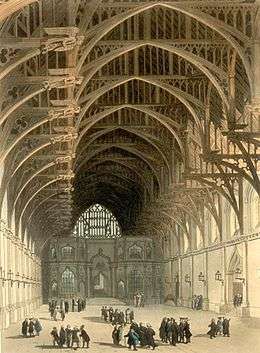English landscape garden
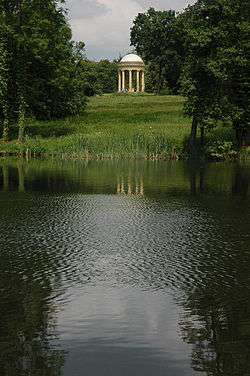
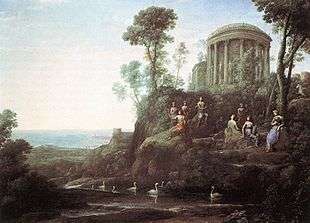
The English landscape garden, also called English landscape park or simply the English garden (French: Jardin à l'anglaise, Italian: Giardino all'inglese, German: Englischer Landschaftsgarten, Portuguese: Jardim inglês, Spanish: Jardín inglés), is a style of "landscape" garden which emerged in England in the early 18th century, and spread across Europe, replacing the more formal, symmetrical jardin à la française of the 17th century as the principal gardening style of Europe.[1] The English garden presented an idealized view of nature. It drew inspiration from paintings of landscapes by Claude Lorrain and Nicolas Poussin, and, in the Anglo-Chinese garden, from the classic Chinese gardens of the East,[2] which had recently been described by European travellers.[2] The English garden usually included a lake, sweeps of gently rolling lawns set against groves of trees, and recreations of classical temples, Gothic ruins, bridges, and other picturesque architecture, designed to recreate an idyllic pastoral landscape. The work of Lancelot "Capability" Brown was particularly influential. By the end of the 18th century the English garden was being imitated by the French landscape garden, and as far away as St. Petersburg, Russia, in Pavlovsk, the gardens of the future Emperor Paul. It also had a major influence on the form of the public parks and gardens which appeared around the world in the 19th century.[3]
History of the English landscape garden

The predecessors of the landscape garden in England were the great parks created by Sir John Vanbrugh (1664–1726) and Nicholas Hawksmoor at Castle Howard (1699–1712), Blenheim Palace (1705–1722), and the Claremont Landscape Garden at Claremont House (1715–1727). These parks featured vast lawns, woods, and pieces of architecture, such as the classical mausoleum designed by Hawksmoor at Castle Howard. At the center of the composition was the house, behind which were formal and symmetrical gardens in the style of the garden à la française, with ornate carpets of floral designs and walls of hedges, decorated with statues and fountains. These gardens, modelled after the gardens of Versailles, were designed to impress visitors with their size and grandeur.[4]
William Kent and Charles Bridgeman
The new style that became known as the English garden was invented by landscape designers William Kent and Charles Bridgeman, working for wealthy patrons, including Richard Temple, 1st Viscount Cobham, Richard Boyle, 3rd Earl of Burlington, and banker Henry Hoare; men who had large country estates, were members of the anti-royalist Whig Party, had classical educations, were patrons of the arts, and had taken the Grand Tour to Italy, where they had seen the Roman ruins and Italian landscapes they reproduced in their gardens.
William Kent (1685–1748) was an architect, painter and furniture designer who introduced Palladian style architecture to England. Kent's inspiration came from Palladio's buildings in the Veneto and the landscapes and ruins around Rome—he lived in Italy from 1709 to 1719, and brought back many drawings of antique architecture and landscapes. His gardens were designed to complement the Palladian architecture of the houses he built.[5]
Charles Bridgeman (1690–1738) was the son of a gardener and an experienced horticulturist, who became the Royal Gardener for Queen Anne and Prince George of Denmark, responsible for tending and redesigning the royal gardens at Windsor, Kensington Palace , Hampton Court, St. James's Park and Hyde Park. He collaborated with Kent on several major gardens, providing the botanical expertise which allowed Kent to realize his architectural visions.[4]
Chiswick House
Kent created one of the first true English landscape gardens at Chiswick House for Richard Boyle, 3rd Earl of Burlington. The first gardens that he laid out between 1724 and 1733 had many formal elements of a Garden à la française, including alleys forming a trident and canals, but they also featured something novel: a picturesque recreation of an Ionic temple set in a theatre of trees. Between 1733 and 1736, he redesigned the garden, adding lawns sloping down to the edge of the river and a small cascade. For the first time the form of a garden was inspired not by architecture, but by an idealized version of nature.[6]
Rousham
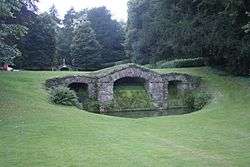
Rousham House in Oxfordshire is considered by some as the most accomplished and significant of William Kent's work.[7] The patron was General Dormer, who commissioned Bridgeman to begin the garden in 1727, then brought in Kent to recreate it in 1737. Bridgeman had built a series of gardens, including a grotto of Venus, on the slope along the river Cherwell, connected by straight alleys. Kent turned the alleys into winding paths, built a gently turning stream, used the natural landscape features and slopes, and created a series of views and tableaus decorated with allegorical statues of Apollo, a wounded gladiator, a lion attacking a horse, and other subjects. He placed "eye-catchers," pieces of classical architecture, to decorate the landscape, and made use of the "ha-ha", a concealed ditch that kept grazing animals out of the garden while giving an uninterrupted vista from within. Finally, he added cascades modelled on those of the garden of Aldobrandini and Pratolino in Italy, to add movement and drama.[8]
Stowe House
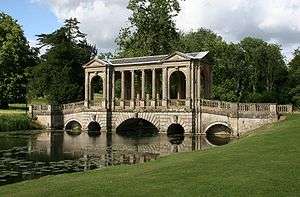

Stowe, in Buckinghamshire, (1730–1738), was an even more radical departure from the formal French garden. In the early 18th century, Richard Temple, 1st Viscount Cobham, had commissioned Charles Bridgeman to design a formal garden, with architectural decorations by John Vanbrugh. Bridgeman's design included an octagonal lake and a Rotunda (1720–21) designed by Vanbrugh.
In the 1730s, William Kent and James Gibbs were appointed to work with Bridgeman, who died in 1738. Kent remade the lake in a more natural shape, and created a new kind of garden, which took visitors on a tour of picturesque landscapes. It eventually included a Palladian bridge (1738); a Temple of Venus (1731), in the form of a Palladian villa; a Temple of Ancient Virtues (1737), with statues of famous Greeks and Romans; a Temple of British Worthies (1734–1735), with statues of British heroes; and a Temple of Modern Virtues, which was deliberately left in ruins, which contained a headless statue of Robert Walpole, Cobham's political rival.[9]
The garden attracted visitors from all over Europe, including Jean-Jacques Rousseau. It became the inspiration for landscape gardens in Britain and on the Continent. (See French landscape garden.)
Stourhead

Stourhead, in Wiltshire (1741–80), created by banker Henry Hoare, was one of the first 'picturesque' gardens, inspired to resemble the paintings of Claude Lorrain. Hoare had travelled to Italy on the Grand Tour and had returned with a painting by Claude Lorrain. Hoare dammed a stream on his estate, created a lake, and surrounded the lake with landscapes and architectural constructions representing the different steps of the journey of Aeneas in the Aeneid by Virgil.[10]
The great age of the English garden
Capability Brown

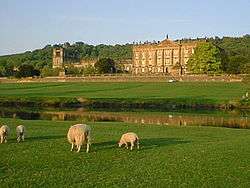
The most influential figure in the later development of the English landscape garden was Lancelot "Capability" Brown (1716–1783) who began his career in 1740 as a gardener at Stowe under Charles Bridgeman, then succeeded William Kent in 1748.
Brown's contribution was to simplify the garden by eliminating geometric structures, alleys, and parterres near the house and replacing them with rolling lawns and extensive views out to isolated groups of trees, making the landscape seem even larger. "He sought to create an ideal landscape out of the English countryside."[11] He created artificial lakes and used dams and canals to transform streams or springs into the illusion that a river flowed through the garden.
He compared his own role as a garden designer to that of a poet or composer. "Here I put a comma, there, when it's necessary to cut the view, I put a parenthesis; there I end it with a period and start on another theme."[12]
Brown designed 170 gardens. The most important were:
- Petworth (West Sussex) in 1752;
- Chatsworth (Derbyshire) in 1761;
- Bowood (Wiltshire) in 1763;
- Blenheim Palace (Oxfordshire) in 1764.
Humphry Repton
Humphry Repton (21 April 1752 – 24 March 1818) was the last great English landscape designer of the eighteenth century, often regarded as the successor to Capability Brown.[13] Repton hit upon the idea of becoming a "landscape gardener" (a term he himself coined) after failing at various ventures and, sensing an opportunity after Brown's death, was ambitious to fill the gap and sent circulars round his contacts in the upper classes advertising his services. To help clients visualize his designs, Repton produced 'Red Books' (so called for their binding)[14] with explanatory text and watercolors with a system of overlays to show 'before' and 'after' views.[15]
In 1794 Richard Payne Knight and Uvedale Price simultaneously published vicious attacks on the 'meagre genius of the bare and bald', criticizing Brown's smooth, serpentine curves as bland and unnatural and championing rugged and intricate designs, composed according to 'picturesque theory' that designed landscapes should be composed like landscape paintings, with a foreground, a middle ground and a background. Early in his career, Repton defended Brown's reputation during the 'picturesque controversy'. However, as his career progressed Repton came to apply picturesque theory to the practice of landscape design. He believed that the foreground should be the realm of art (with formal geometry and ornamental planting), that the middle ground should have a parkland character of the type created by Brown and that the background should have a wild and 'natural' character. Repton re-introduced formal terraces, balustrades, trellis work and flower gardens around the house in a way that became common practice in the nineteenth century.[16]
Repton published four major books on garden design: Sketches and Hints on Landscape Gardening (1795), Observations on the Theory and Practice of Landscape Gardening (1803), An Inquiry into the Changes of Taste in Landscape Gardening (1806) and Fragments on the Theory and Practice of Landscape Gardening (1816).[16] These drew on material and techniques used in the Red Books. These works greatly influenced other landscape-designers including John Claudius Loudon, John Nash, Jean Charles Adolphe Alphand, Hermann Ludwig Heinrich Pückler-Muskau and Frederick Law Olmsted.[16]
The Anglo-Chinese garden
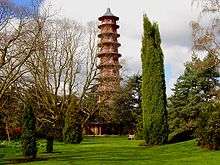
The Far East inspired the origins of the English Garden via Holland. In 1685, the English diplomat in The Hague and writer Sir William Temple wrote an essay Upon the garden of Epicurus (published in 1690), which contrasted European theories of symmetrical gardens with asymmetrical compositions from China, for which he introduced the Japanese term sharawadgi.[17][18][19] Temple had never visited the Far East, but he was in contact with the Dutch and their discourse on irregularity in design, had spoken to a merchant who had been in the Far East for a long time, and read the works of European travellers there. He noted that Chinese gardens avoided formal rows of trees and flower beds, and instead placed trees, plants, and other garden features in irregular ways to strike the eye and create beautiful compositions, with an understatement criticizing the formal compositions of the gardens at the Palace of Versailles of Louis XIV of France.[20] His observations on the Chinese garden were cited by the essayist Joseph Addison in an essay in 1712, who used them to attack the English gardeners who, instead of imitating nature, tried to make their gardens in the French style, as far from nature as possible.[21]
The novelty and exoticism of Chinese art and architecture in Europe led in 1738 to the construction of the first Chinese house in an English garden, in the garden of Stowe House. The style became even more popular thanks to William Chambers (1723–1796), who lived in China from 1745 to 1747, and wrote a book, The Drawings, buildings, furniture, habits, machines and utensils of the Chinese, published in 1757. In 1761 he built a Chinese pagoda, house and garden in Kew, London, as part of Kew Gardens, a park with gardens and architecture symbolizing all parts of the world and all architectural styles. Thereafter Chinese pagodas began to appear in other English gardens, then in France and elsewhere on the continent. French and other European observers coined the term Jardin Anglo-Chinois (Anglo-Chinese garden) for this style of garden.[19][22]
The gothic revival influence on English gardens
In the 1750s, classical architecture and Chinese architecture were joined by gothic revival ruins in English gardens. This was largely the result of Horace Walpole, who introduced gothic revival features into his house and garden at Strawberry Hill in Twickenham.[23]
At Stowe, Capability Brown followed the new fashion between 1740 and 1753 by adding a new section to the park, called Hawkwelle Hill or the gothic promenade, with a gothic revival building.[24]
The English garden spreads to the continent

Descriptions of English gardens were first brought to France by the Abbé Le Blanc, who published accounts of his voyage in 1745 and 1751. A treatise on the English garden, Observations on Modern Gardening, written by Thomas Whately and published in London in 1770, was translated into French in 1771. After the end of the Seven Years' War in 1763, French noblemen were able to voyage to England and see the gardens for themselves, and the style began to be adapted in French gardens. The new style also had the advantage of requiring fewer gardeners, and was easier to maintain, than the French garden.[25]
One of the first English gardens on the continent was at Ermenonville, in France, built by marquis René Louis de Girardin from 1763 to 1776 and based on the ideals of Jean Jacques Rousseau, who was buried within the park. Rousseau and the garden's founder had visited Stowe a few years earlier. Other early examples were the Désert de Retz, Yvelines (1774–1782); the Gardens of the Château de Bagatelle, in the Bois de Boulogne, west of Paris (1777–1784); The Folie Saint James, in Neuilly-sur-Seine, (1777–1780); and the Château de Méréville, in the Essonne department, (1784–1786). Even at Versailles, the home of the most classical of all French gardens, a small English landscape park with a Roman temple was built by the Petit Trianon and a mock village, the Hameau de la reine, Versailles (1783–1789), was created for Marie Antoinette. (See the French landscape garden).
The new style also spread to Germany. The central English Grounds of Wörlitz, in the Principality of Anhalt, was laid out between 1769 and 1773 by Prince Leopold III, based on the models of Claremont, Stourhead and Stowe Landscape Garden. Another notable example was The Englischer Garten in Munich, Germany, created in 1789 by Sir Benjamin Thompson (1753–1814).
In the Netherlands the landscape-architect Lucas Pieters Roodbaard (1782-1851) designed several gardens and parks in this style. The style was introduced to Sweden by Fredrik Magnus Piper.
The style also spread rapidly to Russia, where in 1774 Catherine the Great adapted the new style in the park of her palace at Tsarskoe Selo, complete with a mock Chinese village and a Palladian bridge, modeled after that at Wilton House.
Characteristics of the English garden
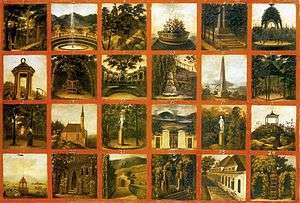
The continental European "English garden" is characteristically on a smaller scale and more filled with "eye-catchers" than most English landscape gardens: grottoes, temples, tea-houses, belvederes, pavilions, sham ruins, bridges and statues, though the main ingredients of the landscape gardens in England are sweeps of gently rolling ground and water, against a woodland background with clumps of trees and outlier groves. The name—not used in the United Kingdom, where "landscape garden" serves—differentiates it from the formal baroque design of the garden à la française. One of the best-known English gardens in Europe is the Englischer Garten in Munich.
The dominant style was revised in the early 19th century to include more "gardenesque"[26] features, including shrubberies with gravelled walks, tree plantations to satisfy botanical curiosity, and, most notably, the return of flowers, in skirts of sweeping planted beds. This is the version of the landscape garden most imitated in Europe in the 19th century. The outer areas of the "home park" of English country houses retain their naturalistic shaping. English gardening since the 1840s has been on a more restricted scale, closer and more allied to the residence.
The canonical European English park contains a number of Romantic elements. Always present is a pond or small lake with a pier or bridge. Overlooking the pond is a round or hexagonal pavilion, often in the shape of a monopteros, a Roman temple. Sometimes the park also has a "Chinese" pavilion. Other elements include a grotto and imitation ruins.
A second style of English garden, which became popular during the 20th century in France and northern Europe, is the late 19th-century English cottage garden.[27]
Gallery
-

Claremont Belvedere
-
.jpg)
Bowood House Gardens, by Capability Brown
-

Garden of Pavlovsk Palace near St. Petersburg
-

Grotto at Bowood House, by Capability Brown
-

Petworth House Garden, by Capability Brown
-
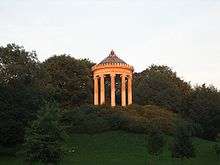
The Monopteros in the Englischer Garten in Munich
-

Ruins and a grotto in Dessau-Wörlitz
-

The pond in Sheffield Park Garden
-

The Chinese Tower in the Englischer Garten in Munich
-
Pavilion Shapel in Tsarskoe Selo, Russia
See also
- List of landscape gardens
- French landscape garden
- German garden
- Landscape gardens topics
- Landscape design history
- Historic garden conservation
References
- ↑ Yves-Marie Allain and Janine Christiany, L'Art des jardins en Europe, Citadelles and Mazenod, Paris, 2006.
- 1 2 Boults, Elizabeth; Chip Sullivan (2010). Illustrated History of Landscape Design. John Wiley and Sons. p. 175. ISBN 0-470-28933-3.
- ↑ Lucia Impelluso, Jardins, potagers et labyrinthes, Mondatori Electra, Milan
- 1 2 Philippe Prevot, Histoire des jardins, Editions Sud Ouest, 2006
- ↑ See Allain and Christiany, pg. 280.
- ↑ Lucia Impelloso, Jardins, potagers et labyrinthes, pg. 90.
- ↑ See John Dixon Hunt, Garden and Grove, London 1986.
- ↑ Allain and Christiany, pg. 290
- ↑ Lucia Impelluso, Jardins, potagers et labyrinthes, pg. 96.
- ↑ Impelluso, Jardins, potagers et labyrinthes, pg. 95.
- ↑ Allain and Christiany, pg. 282.
- ↑ Cited in Allain and Christiany, pg. 282.
- ↑ Patrick Goode Ed. (2009) The Oxford Companion to Architecture, Oxford University Press ISBN 978-0-1986-0568-3
- ↑ Patrick Taylor Ed. (2006) The Oxford Companion to the Garden, Oxford University Press ISBN 978-0-1986-6255-6
- ↑ John Cannon (2009) The Oxford Companion to British History, Oxford University Press ISBN 9780199567638
- 1 2 3 James Stevens Curl (2006) A Dictionary of Architecture and Landscape Architecture,Oxford University Press ISBN 978-0-1986-0678-9
- ↑ See Wybe Kuitert "Japanese Art, Aesthetics, and a European discourse - unraveling Sharawadgi" Japan Review 2014 ISSN 0915-0986 (Vol.27)
- ↑ Chang, Elizabeth Hope (2010). Britain's Chinese eye: Literature, empire, and aesthetics in nineteenth-century Britain. Stanford: Stanford University Press. p. 28. ISBN 978-0-8047-5945-8.
- 1 2 Stepanova, Jekaterina (2010). Kraushaar, Frank, ed. Eastwards: Western views on East Asian culture. Bern: Peter Lang. pp. 155–156. ISBN 978-3-0343-0040-7.
- ↑ see Wybe Kuitert "Japanese Robes, Sharawadgi, and the landscape discourse of Sir William Temple and Constantijn Huygens" Garden History, 41, 2: (2013) p.172
- ↑ Michel Baridon, Les Jardins- Paysagistes, Jarininiers, Poetes. Pg. 839-40.
- ↑ Chang, Elizabeth Hope (2010). Britain's Chinese eye: Literature, empire, and aesthetics in nineteenth-century Britain. Stanford: Stanford University Press. p. 18. ISBN 978-0-8047-5945-8.
- ↑ Allain and Christiany, pg. 280
- ↑ Allain and Christiany, pg. 307
- ↑ Allain and Christiany, pg. 316-318.
- ↑ The term gardenesque was introduced by John Claudius Loudon.
- ↑ From Peasants to Monet - Triumph of English Cottage Gardens
Bibliography
- Kuitert, Wybe, Japanese Robes, Sharawadgi, and the landscape discourse of Sir William Temple and Constantijn Huygens Garden History, 41, 2: (2013) p. 172
- Kuitert Wybe, Japanese Art, Aesthetics, and a European discourse - unraveling Sharawadgi Japan Review 2014 ISSN 0915-0986 (Vol.27)http://publications.nichibun.ac.jp/region/d/NSH/series/jare/2014-08-29/s001/s006/pdf/article.pdf
- Clark, H.F., The English Landscape Garden. London, Pleiades. 1948.
- Hussey, Christopher, English Gardens and Landscapes 1700-1750. London, Country Life. 1967.
- Prince, Hugh, Parks in England. Shalfleet Manor, Pinhorns Handbooks: Two. 1967.
- Hunt, John Dixon, The Genius of the Place. The English Landscape Garden 1620-1820. London, Elek. 1975.
- Jarret, David, The English Landscape Garden. London, Academy. 1978.
- Stuart, David C., Georgian Gardens. London, Hale. 1979.
- Jacques, David, Georgian Gardens. The Reign of Nature. London, Batsford. 1983.
- The English Garden, Phaidon Press, London, 2008.
- Yves-Marie Allain and Janine Christiany, L'art des jardins en Europe, Citadelle at Mazenot, Paris, 2006
- Lucia Impelluso, Jardins, potagers et labyrinthes', Mondatori Electra, Milan
- Philippe Prévôt, Histoires des jardins, Éditions Sud Ouest, Bordeaux 2008
- Michel Baridon, Les Jardins - Paysagistes. Jardiniers, Poetes. Editions Robert Laffont, Paris, 1998.
- Laird, Mark (1999). The flowering of the landscape garden: English pleasure grounds, 1720-1800. University of Pennsylvania Press. Retrieved March 16, 2012. ISBN 081223457X
- Francis, Mark; Reimann, Andreas (1999). The California landscape garden: ecology, culture, and design. University of California Press. Retrieved March 16, 2012. ISBN 0520214501
- Worpole, Ken & Orton, Jason, The New English Landscape, Field Station, London, 2014.
External links
| Wikimedia Commons has media related to English gardens. |
